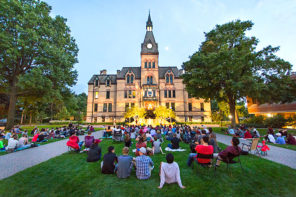As this article goes to press, Assad’s Syrian regime continues its campaign of brutal repression against activists, arresting dozens of women just yesterday in the wake of a 5000-strong sit-in on a highway in north-eastern Syria. -Eds
A consciousness change is happening in Syria, a country of twenty-three million that has been brutalized under Martial Law since 1963. My parents left in 1971 with their children, including me, because the repression of civil liberties had already become intolerable. The sense of helpless terror became so ingrained among Syrians that relatives who remained in Syria spoke only in hushed tones and coded words about the brutality of the state—even, incredibly, when they were visiting us in our suburban U.S. home, miles from the reach of any Syrian state police agent.
Unlike the Muslim Brotherhood-dominated rebellion of 1979-1984, whose dark events and ultimate failure overshadowed my youth despite our move to America, the new protest movement is grass-roots, nonsectarian, and nonviolent. Signifying an incredible awakening to individual empowerment that is as deeply personal for its participants as it is political, this movement is largely unaffiliated with political parties, and cuts across economic class, with a strong showing in the countryside.
While the regime claims a progressive agenda on gender, neither women nor men are free in an authoritarian state. Women and children are at the forefront of the movement for freedom in Syria, a movement as inclusive as Syria is diverse.
In the Lead-up to Day of Dignity: Children Imprisoned
Two dozen schoolchildren tagged the walls of Syria’s southern city of Daraa with the phrase being heard in dictatorships across the Arab world, The people want! To topple the regime! For this, fifteen children of Dara, from nine years to fourteen years old, were dragged to prison on March 5. That they were tortured, the fingernails of some reportedly pulled out, would emerge later. This, while in the north in early February crackdowns, five Kurdish children ages fourteen to sixteen were arrested.
No longer was Syria’s youngest prisoner of conscience schoolgirl Tal Mallohi, arrested at seventeen in 2009 for blogging empathy with Gazans and Gandhi, and feelings of equality with her country’s president. Let’s not forget young Tal as this story unfolds, nor the many other women and men who have been behind bars in Syria since before the revolution began, including dentist and mother Tehama Marouf (who happens to be Alawite), hungerstriking since February 18 against inhuman prison conditions.
Kurds in Syria’s northern city of Qamishli cried, “honor our fallen!” on March 12, anniversary of Kurdish deaths at state hands in 2004 and 2008. Wielding the microphone over the throng of fifteen hundred was a woman, Harvene Awsi, a representative in one of Syria’s Kurdish parties. In ringing tones, she called for repeal of emergency laws, release of prisoners, and freedom. The crowd chanted—The people want! To topple the regime!—presaging masses who would pick up that song in twenty-nine Syrian cities on Dignity Friday, March 18.
Tuesday, March 15 was supposed to be the big date: Organizers of Facebook’s Syrian Revolution page called on Syrians to protest on that day. Who plans a revolution on a Tuesday? The day saw flutters of activity and arrests.
Then, the next day, a dozen and a half women were arrested for saying, “release our prisoners!” And that tipped the bucket.
On March 16, family members of prisoners of conscience gathered in Damascus in front of “Justice Palace” to demand the release of political prisoners. This sit-in was planned by those inside Syria, and termed by organizers not a “protest” but “اعتصام الاهآلي” in Arabic, or “Family Vigil,” short for Vigil of the Families of Prisoners. Men, women, and children with placards of imprisoned family members demanded audience with the Interior Minister.
“Wait here,” they were told. Then came security forces, dispersing them with clubs. One man used the classic nonviolence technique of going limp as they arrested him. Another was gashed in the head.
Syria’s security forces conducted themselves with their typical violence and cruelty. A participant said that the instant a ten-year-old son of one woman prisoner held up a photograph of his mother, a security man’s blow sent the child reeling into onlookers. Suhair Attasi was pulled by her hair to a van, as were other women. Six-month-pregnant Maimouna Alammar was grabbed and carted off.
What Syria experienced that day was a scene of loving families—women, men, and children together—appealing for their imprisoned loved ones in front of the offices that were supposed to serve the public, getting clubbed by armed men. Many more were attacked than the eighteen women and fourteen men who were charged the next day. Even though the two most egregious captures that day, those of Alammar and the ten-year-old boy, were followed by their release within hours, the vileness of the moment had been broadcast across the world, by callers who described the incident on television, and eyewitnesses who spread the news by word of mouth.
Men were assaulted too on March 16, in downtown Damascus’ Marjeh Square, full of governmental buildings, a location loaded with symbolism of the state’s image. But it was the disgustingly-conducted public attacks on some two dozen women in that key location that became the drop that tipped the bucket. While many Syrian women are already behind bars for crimes of expression, March 16 saw the public beating of women who, alongside their other roles including savvy human rights activist, were there that day as mothers, sisters, wives, and daughters of political prisoners.
At least eighteen women were arrested that day, teenagers to grandmothers, according to the Haitham Maleh Foundation for Prisoners of Conscience in Syria. Some had a record as human rights defenders, such as lawyer Razan Zaitouneh, activist Suhair Atassi, and the same Awsi who had lead Qamishly’s mourning day. All three are Damascus Declaration signatories, incidentally, and Atassi had been organizing nonviolent civil disobedience actions in Damascus since January 28, which had emboldened increasing numbers of young women and men. Several who gathered on March 16 were from Daraa, including Meimuna Alammar and journalist Dana Jawabra. And no wonder; Daraa had fifteen new prisoners as of March 5: the children.
The Dignity of Women
What happened to the Women of March 16, like what happened to the still-imprisoned young Tal Mallohi (sentenced on February 5 to five more years for “espionage”), made a powerful moral statement to Syrians. This, despite the fact that the first thing security did in its assault that day was confiscate cell phones, so that footage of the indignities suffered that day is not available. Word gets around to the Syrian public, despite regime’s stifling of news. The indignities to which women in particular were subjected struck a chord which then reverberated two days later, on “Dignity Friday.”
Daraa felt a double blow: Its children were taken, then women who went to save the children were taken.
After these March 16 assaults, Syrian protest was no longer about some political concept that might be considered abstract by masses beaten by survival; it was no longer some plan that could be dismissed as led by “conspirators” outside Syria. If the protests planned on Facebook for March 15 produced tepid results, March 18, dubbed “Dignity Friday,” saw between 300,000 and 400,000 people on the streets across Syria.
Daraan men would take the first bullets in their bodies as the government unleashed firepower on unarmed protesters. More protests across the country were then galvanized by outrage at the Daraa massacre.
In those segments of the Syrian revolt, it is mostly men’s faces and bodies that we see, their brave sacrifice. The courage of most post-March 18 women protesters—and they are certainly there—is only beginning to surface in footage. That absence caused many to wonder, “where are the Syrian women?”
Yet the courage of the Women of March 16 is one key reason for that surge on Dignity Friday. The Kurds of the north have also been playing a role all along, at the front of fearlessness, priming the masses for speaking out. And the children led the way.
Let us remember, as the story of this revolution is told, that it is not the story of any one person, group—or gender—but of many hands working together. And let us not forget that the dignity of women, equally with that of men, was one of the motivators of the struggle.




